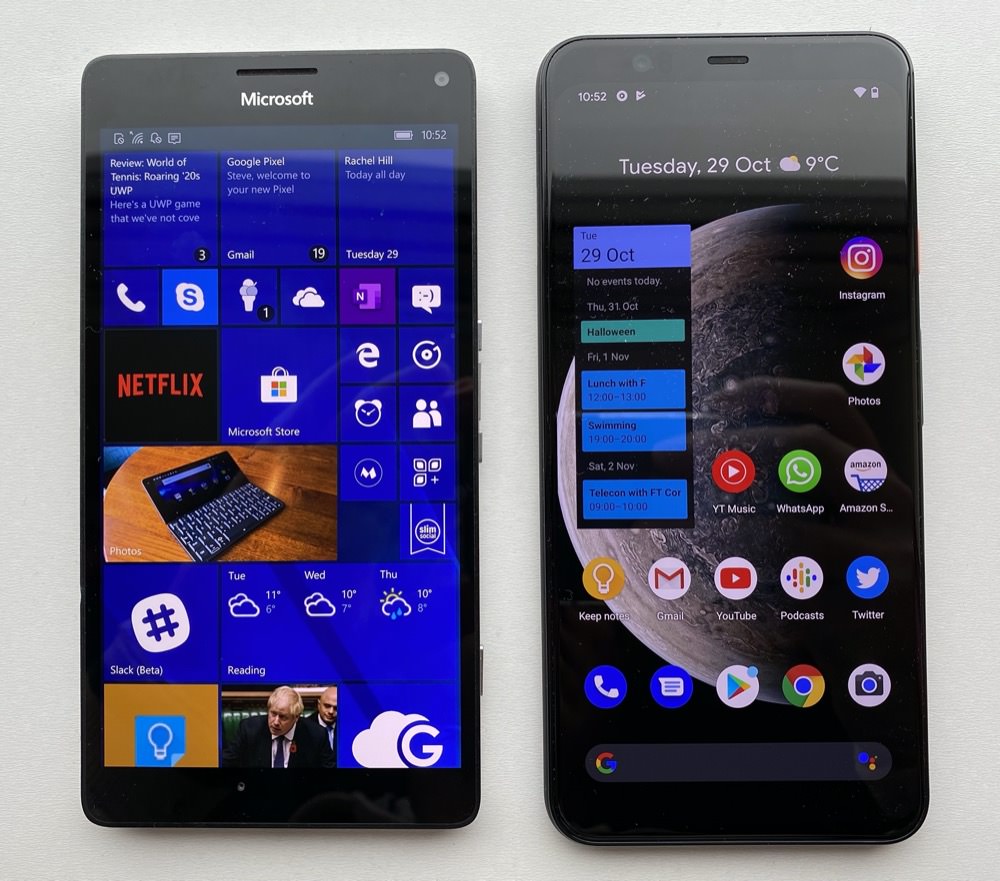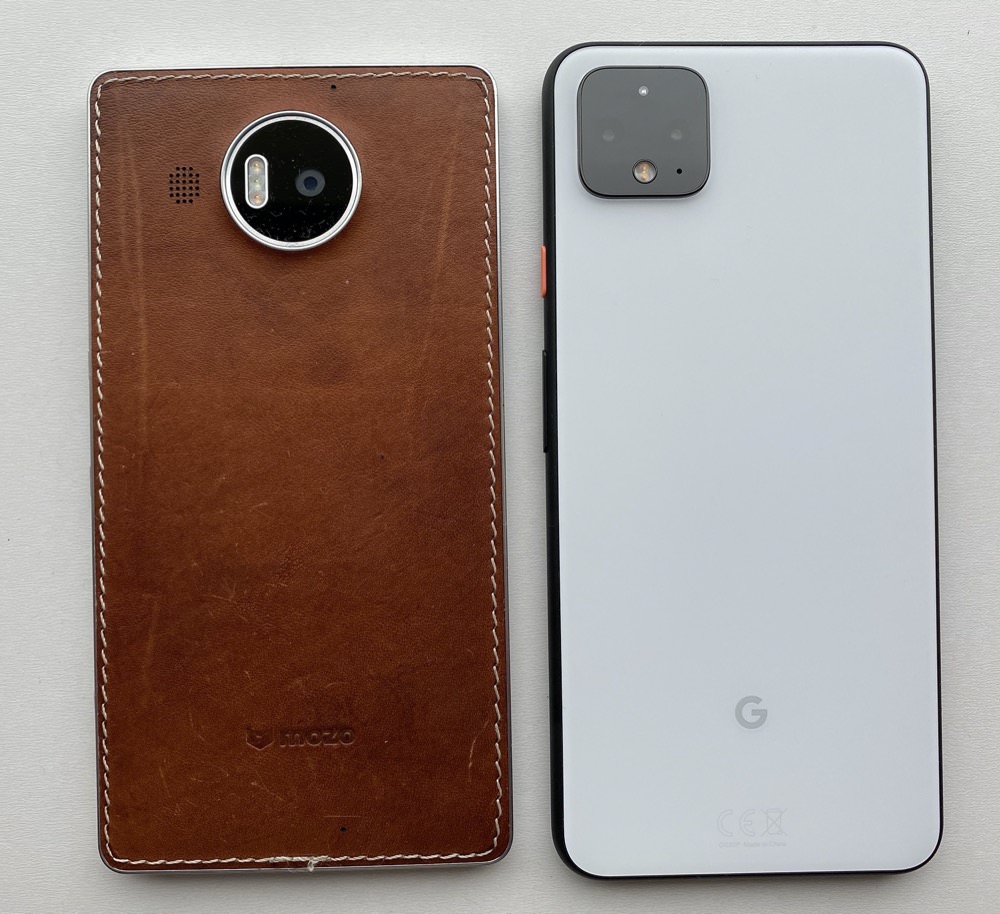
Although there's a little life left in Windows 10 Mobile in terms of updates and support, new hardware is non-existent, plus repairs and spares for older hardware are heading the same way - so it makes sense for everyone to be aware of the best of the rest from other platforms. The Pixel 4 XL is interesting (despite the price) for being 100% Google and having the most up to date Android implementation in the world - and guaranteed updates for many years.

As usual, I've shaded in green an obvious 'win' for either device. Any row where a winner would be totally subjective is left uncoloured. Or, where all devices are utterly excellent but in different ways, I've given each a 'green'(!)
[By the way, if you're viewing this feature on a phone then the table may well cause you problems. Try viewing in landscape mode? Failing that, go view this on a laptop or tablet!]
| Microsoft Lumia 950 XL | Google Pixel 4 XL | |
| Date first available | November 2015 | October 2019 |
| Current price, availability | No longer officially for sale, though it's often on clearance prices if you're lucky and at outrageous profiteering prices due to rarity (if you're not!) | £829 from the UK Google Store for the 64GB variant. £929 for the 128GB version. Ouch. |
| Dimensions, form factor, weight |
152 x 78 x 8mm, plastic chassis and replaceable backs (plastic/leather/wood etc, from Mozo, as modelled here!), 165g, bezels are comparatively small |
160 x 75 x 8mm, 193g, coated glass and metal - I fear a bit for the coatings with wear and tear (witness Mozo cases after a year!) But with a case in place it'll be fine. |
| Durability | No specific durability metrics, though the fact that the back comes off will help enormously for water damage, i.e. taking out battery and cards immediately, drying out the internals, even unscrewing the motherboard from the guts of the phone. I'm old-school here! All damage to the back or corners is trivial through replacement of the rear, but the screen's exposed, of course. The plastics used should absorb shock and, anecdotally, I've never bothered putting a case on any Lumia. Just saying. I think that fact is significant. |
IP68 for liquid and dust, but I maintain that today's smartphones are more like jewels and need protection from drops and scrapes. And if water does get in (e.g. a SIM tray not sealed properly) then there's no way for a user to get inside and clean things up, dry components, etc. I guess I'm just old school here! |
| Operating system, interface | Windows 10 Mobile, (dismissable) virtual controls, as needed, now officially updated to W10 Fall Creators Update (Redstone 3, Autumn 2017) with security to 'October 2019'. | Android 10, bang up to date, October 2019 security, of course. Google's Pixel Launcher. |
| Display |
5.7" AMOLED (1440p at 16:9 aspect ratio, matching most video media), Gorilla Glass 4, ClearBlack Display polarisers help with outdoor contrast, excellent viewing angles. Screen area is approximately 88 cm2 Glance screen available (in various colours) for always-on time, day and notification icons, plus some detailed info from a specified app, give the Lumia a bonus point here. |
6.3" 1440p (LG-made, unlike the Pixel 3 range's Samsung panels) P-OLED at 19:9 aspect ratio, Gorilla Glass 5, screen area is 98cm2 Glance screen is available with date, time, battery status and some notification icons, though most of the time you won't get to examine these in detail because the phone just unlocks through its face ID system so quickly(!) |
| Connectivity |
LTE, NFC (all uses), Wi-Fi b/g/n/ac, integral wifi tethering, Bluetooth 4.2 (all uses). Continuum connectivity to use a wide range of first and third party UWP apps on external displays as secondary screen, independent of the phone display. Hoping to report soon on the retail NexDock 2, transforming the Lumia into a Windows 10 S laptop, effectively. |
LTE, NFC (all uses), Wi-Fi b/g/n/ac, integral wifi tethering, Bluetooth 5.0 (all uses). No HDMI out 'smarts' or desktop modes. At least not yet - Google keep promising something... |
| Processor, performance | Snapdragon 810 chipset, 3GB RAM, faster than it's ever been now on the Fall Creators Update though still slower for almost everything than on the Android phone. Multi tasking and app resumption is excellent though, at least with all the modern UWP apps |
Snapdragon 855, 6GB RAM, lightning fast at everything. |
| Capacity | 32GB internal storage, expandable via (cheap) microSD to extra 256GB | 64/128GB internal storage, depending on variant |
| Imaging (stills) |
20MP PureView f/1.9 1/2.4" BSI sensor, Phase Detection auto-focus, dedicated camera shutter button and launch key, genuine 2x lossless digital zoom (in 8MP oversampled mode), OIS. 'Rich Capture' produces customisable HDR shots and 'dynamic flash', with triple LED illumination. Outstanding shots in most light conditions, with just focussing issues in low light as an Achilles heel. 5MP front camera, no auto-focus |
12.2 MP, f/1.7, 1/2.55", Dual Pixel PDAF, OIS Google's usual HDR+ Camera software does a terrific job on keeping detail high, with the higher megapixel telephoto delivering up to 5x genuine lossless zoom with multi-exposure computational methods. Imaging comparison coming soon! 8MP, f/2.0 front camera, no auto-focus |
| Imaging (video) | Up to 4K, optically (and optionally digitally) stabilised, with 'Best photo' 8MP grabbing built-in, plus Rich Recording and HAAC microphones for high quality, gig-level stereo capture. | Up to 4K video capture, with EIS, high quality stereo audio capture. |
| Music and Multimedia (speakers) |
A tinny mono speaker by modern standards, though as ever you can trade volume for fidelity in a simple tweak on Lumias. | Stereo speakers, excellent results, even though the right/bottom one is no longer front facing, as on the Pixel 3 range... Audio is 'processed', as on the iPhone 11 Pro that I liked here, but the net result is more bass, more top end, more punch, so I'm happy! |
| Music (headphones) |
3.5mm headphone jack, A2DP+AptX, so great wired and wireless headphone audio too. | A2DP and AptX HD for Bluetooth audio. Audio output via Type C jack is possible with an active DAC/dongle, but none such is supplied in the box, so you have to buy one. (You don't even get Type C headphones, which seems a bit cheap by Google for such an expensive product.) |
| Navigation |
Windows 10 Maps is now pretty mature and impressive, especially once you've learned the live traffic routine trick! Offline maps save a lot of data bandwidth for those on tight contracts or anyone in a low signal (data) area, and these get the win here. |
Google Maps is now the gold standard in phone navigation, tied in with many other Google services and offering true real time navigation around traffic issues, along with offline maps that auto-update. |
| Cortana/Voice | Cortana is now mature and well integrated, though some functionality has been falling away, e.g. recognising ambient music, plus there are reliability concerns under Windows 10 Mobile. | Google Assistant is baked in and works well (activated from the lockscreen or via voice), arguably superior to Cortana in 2019, due to the investment that Google has put in over the last few years. |
| Battery, life | Removable 3000mAh battery, and the ability to change cells gets the win here, plus USB Type C Power Delivery (up to 3A, so 15W) and 1A Qi wireless charging built-in. However, a Lumia running Windows 10 Mobile will now discharge in 24 hours even if you don't use it much. |
Sealed 3700mAh battery, just about gets through a day at the moment, though battery life should improve with software updates (first one eagerly expected for first week November 2019). Power Delivery 2.0, up to 18W fast charging. 1A Qi wireless charging built-in. |
| Cloud aids | Windows Photos syncs across all signed-in devices, subject to your OneDrive tariff (stingy, unless you have Office 365), should you have thousands of images in the system. Plus Windows 10 backs all your media, application data and settings to a separate backup folder system, tariff-free on OneDrive, for easy restoration on a new or factory reset phone. | Google Photos does a great job of organising photos and syncing them across all signed-in phones and tablets, albeit at 'reduced' quality (re-compression server-side). (The original Pixel 'original quality' offer for previous series doesn't apply to the 4 series, with Google steering people to paying for a cloud plan if they want this service.) |
| File compatibility | As with all Windows phones, plugging into a Windows PC gives full drag and drop to the phone's user file system. Plugging into a Mac sadly isn't possible anymore. | Plugging into a PC gives immediate MTP file access, plus this works well on a Mac with Google's Android File Transfer utility, for drag and drop of all user files. |
| Biometrics | Iris recognition ('Windows Hello') works well unless you wear varifocals(!), but takes a couple of seconds (including an animation!) in real world use. There's also no official way of paying in shops using this, at least not in most of the world. | Front-facing infrared face identification system works superbly, even with glasses and other facial furniture (beards, etc.) It's instant, being driven by a fast chipset and also by the 'Soli' radar scanning kicking off the ID process even before your face is fully visible. (Critics have pointed out that it currently doesn't require eyes open, but this is to be tweaked in an update, apparently.) |
| Applications and ecosystem | Windows 10 Mobile has most (though not all) mainstream apps and services covered. Often third party clients are involved, mind you, there are companies who hate Microsoft so much that they simply refuse to write for Windows, it seems. And 'long tail' niche/boutique apps are hard to find for real world companies and shops. |
The might of Google and Android's app ecosystem - everything is available and almost always in first party form. |
| Upgrades and future | Windows 10 Mobile will be updated through the end of 2019 - after that the OS will be useable but with more and more service caveats applying. Still, 'end 2019' is a full four years since the Lumia 950 XL was launched, so it's hard to complain. | Google promises three years of software and security updates, including at least two major Android version updates. It has a great track record too, I believe it. Yes, three years is still less than the 950 XL's four and less than iOS and the iPhone, which runs to around five years, but it's still excellent for the inconsistent Android world. |
Verdict
Adding up the green 'wins' (for fun?!) gives a 10-8 win to the much newer device, of course, though despite my somewhat provocative scoring(!) I think some people will be surprised by how close the four year old Lumia gets to the latest and greatest from Google! Imaging is still up for grabs and this will be a crucial battlefield for many readers, so I'll report back on that in due course!
Your comments welcome.
